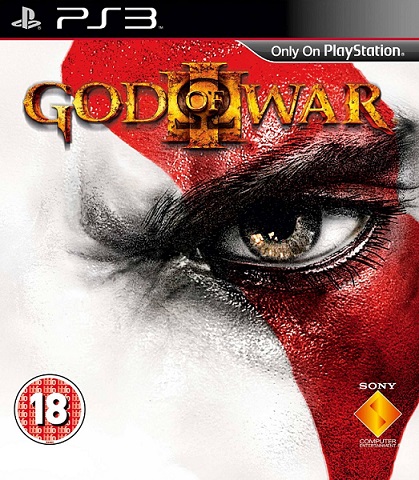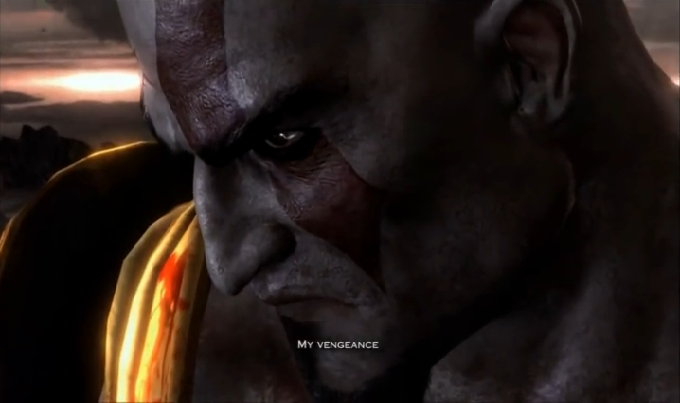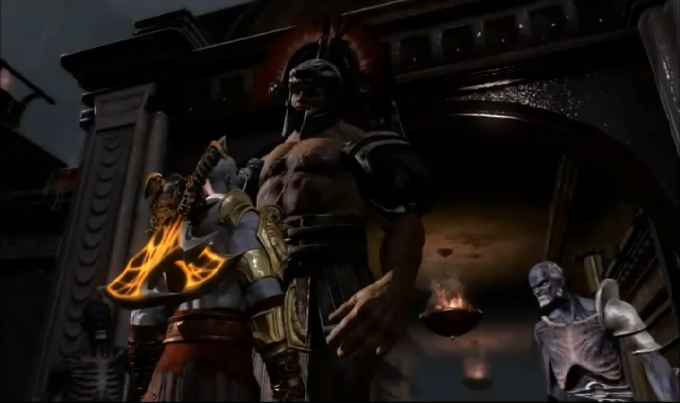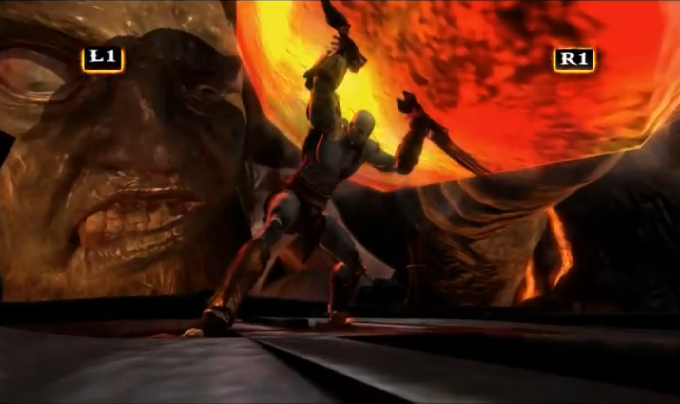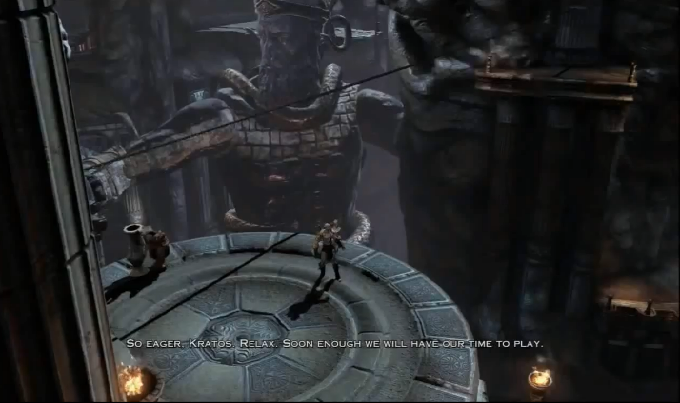GOD OF WAR III (PS3)
As one of Sony’s biggest franchises, God of War managed to refine and define the hack ‘n’ slasher with its first instalment. But it raises an interesting question: how do you fix what is not broken? God of War II proved that despite lingering familiarity, it could still be a top action game, if not as praiseworthy as its predecessor. God of War III is also a familiar trek, but thanks to a boost from more powerful hardware and some incredible moments, it is a game still very worthy of your time, and it wraps up the series nicely.
Kicking things off in grand style, GoW3 sees anti-hero Kratos seeking vengeance against Zeus. With titans by his side, he scales Mount Olympus to confront the God of Thunder. But things quickly go downhill, as Kratos perishes (again), ditched like a used-up tool by Gaia. Drained of his powers and trapped in Hades, Kratos must ascend back into Olympus while killing any God, titan or poor soul in his way. This is where the story loses some of its lustre, as while Kratos was never exactly a charming chap, his nastiness is turned up to eleven in this one. He murders people despite them offering assistance, and it becomes repulsive. That being said, his journey for both vengeance and redemption is satisfying enough, with a rather interesting conclusion which finishes the series nicely.
If God of War III gets one thing right, it’s making a big first impression. I can’t remember the last game which opened up in such grand fashion. As you ride a titan while scaling the Mountains of Olympus, you’re somewhat thrown into the deep-end, with light messages teaching you how to play. Soon, you’ll be squaring off with Poseidon in an impressive, multi-stage boss fight, all the while chaos is ensuing around you as the god of the oceans pummels other titans. It showcases the technical power behind the game, and drops your jaw multiple times. Most competing games don’t have endings this epic, let alone serve as the opening sequence. But in a way, that’s also its Achilles’ heel, as much like the protagonist, the experience somewhat falls into a pit.
Perhaps it was unwise to leave the second game on such a cliffhanger, pushing an epic battle into the beginning of a sequel. It opens the game on such a high that when the comedown kicks in, you’re left somewhat deflated. It’s a bit like giving you a taste of fast food, only to force you on a diet of salad. Not only that, it starts to reek of déjà vu, as Kratos is once again trapped in Hades with his powers and abilities removed. This echoes the second game far too closely, and the experience never seems to find its footing after that. The tight pacing which the series is known for just isn’t present, with a couple of dull stretches such as the first time you explore the Chamber of Flame.
That’s not to say the sequel is lacking, and there is plenty to love throughout your ten hour quest. Slashing creatures up remains fun, though again some reused elements make the game feel rehashed. This is in regards to weapons mainly, as rather than construct four unique weapons, three of them feel eerily similar to the starting Blades of Chaos, and only the Nemean Cestus –a pair of powerful gauntlets – stand out. And while enemies are glossed up in HD courtesy of the PS3’s power, most are familiar. Though weapons and enemies can lack variety, the amount of combos and the blood-thirsty nature of combat is good fun.
Puzzles have seen the most change, and it’s definitely for the better. Sony Santa Monica has added a ton of new puzzle concepts. One of the more interesting ones comes from a place called Hera’s Garden. It is essentially a maze to navigate, and though that may not seem all that enthralling, an artefact you gain allows you to view the environment from an alternate camera angle through button presses, opening up different paths as the environments merge into one. It is probably the coolest puzzle in the game, and plenty of other complex challenges come your way, including the challenging Labyrinth which mixes challenging combat and tricky, time-based puzzles.
Speaking of challenge, GoW3 gives plenty of that. On the harder difficulties, many of the foes you encounter are tough to kill, though they usually can be bested with perseverance. Bosses, however, are a different level of intense. Even on normal difficulty, later bosses are incredibly challenging, and in particular, the final boss is a complete b*stard to beat. They often rely on a mix of defence and offense, and punish any mistakes as bosses take off large chunks of health with single attacks. Many of the bosses vary too, as smaller, though plenty tough, baddies are mixed with screen-filling abominations. And like before, brutal QTEs finish the fights in grand fashion. Anyone who is planning to tackle Titan mode should definitely prepare themselves for frustration.
That’s not to say the sequel is lacking, and there is plenty to love throughout your ten hour quest. Slashing creatures up remains fun, though again some reused elements make the game feel rehashed. This is in regards to weapons mainly, as rather than construct four unique weapons, three of them feel eerily similar to the starting Blades of Chaos, and only the Nemean Cestus –a pair of powerful gauntlets – stand out. And while enemies are glossed up in HD courtesy of the PS3’s power, most are familiar. Though weapons and enemies can lack variety, the amount of combos and the blood-thirsty nature of combat is good fun.
Puzzles have seen the most change, and it’s definitely for the better. Sony Santa Monica has added a ton of new puzzle concepts. One of the more interesting ones comes from a place called Hera’s Garden. It is essentially a maze to navigate, and though that may not seem all that enthralling, an artefact you gain allows you to view the environment from an alternate camera angle through button presses, opening up different paths as the environments merge into one. It is probably the coolest puzzle in the game, and plenty of other complex challenges come your way, including the challenging Labyrinth which mixes challenging combat and tricky, time-based puzzles.
Speaking of challenge, GoW3 gives plenty of that. On the harder difficulties, many of the foes you encounter are tough to kill, though they usually can be bested with perseverance. Bosses, however, are a different level of intense. Even on normal difficulty, later bosses are incredibly challenging, and in particular, the final boss is a complete b*stard to beat. They often rely on a mix of defence and offense, and punish any mistakes as bosses take off large chunks of health with single attacks. Many of the bosses vary too, as smaller, though plenty tough, baddies are mixed with screen-filling abominations. And like before, brutal QTEs finish the fights in grand fashion. Anyone who is planning to tackle Titan mode should definitely prepare themselves for frustration.
Though it may not rank up there with the previous two instalments – mainly in terms of pacing – the game is still plenty lengthy. It’ll take you about ten hours to crush the game on normal difficulty, and you could probably add a few hours for Titan mode. New Game+ is available, but you can’t bring upgrades over to higher difficulties. It makes sense, as many of the game’s areas require backtracking which upgrades would allow, but it’s a shame still. And again, Challenges of Olympus are available, though I bested them in around fifteen minutes.
One area which is still superb is the game’s presentation, as God of War III is one of the best looking and sounding games of the seventh generation. Kratos is the highlight, with an insane amount of detail which brings him to life, even if his actual behaviour isn’t always endearing. The monster designs, though familiar, also are impressive. Animation is consistently smooth, keeping combat flowing. The environments stand out, filled with excellent details and anchored by tight camera angles that balance visibility with showmanship. The audio is top too, featuring stronger voice work than the previous game, grisly sound effects which enhance combat and a superb score which mixes familiarity with exciting new sounds. It is an audiovisual treat.
Perhaps, then, God of War III is somewhat guilty of being a show-off. It certainly is the most impressive instalment of the series technically, with incredible graphics and sound. Unfortunately, though the gameplay is still fun, it doesn’t feel as tightly woven as previous games. The epic beginning acts like a double-edged sword, knocking you out of your seat and then giving too much breathing room to let you get back on, and the pacing never seems to get back on track. Combat is familiar but fun, and some of the puzzles are the best in the series, but it’s not as balanced as previous games. The story also feels morally muddled, and Kratos can be quite unlikable at times. That being said, it is a satisfying conclusion, and fans of the series won’t complain.
One area which is still superb is the game’s presentation, as God of War III is one of the best looking and sounding games of the seventh generation. Kratos is the highlight, with an insane amount of detail which brings him to life, even if his actual behaviour isn’t always endearing. The monster designs, though familiar, also are impressive. Animation is consistently smooth, keeping combat flowing. The environments stand out, filled with excellent details and anchored by tight camera angles that balance visibility with showmanship. The audio is top too, featuring stronger voice work than the previous game, grisly sound effects which enhance combat and a superb score which mixes familiarity with exciting new sounds. It is an audiovisual treat.
Perhaps, then, God of War III is somewhat guilty of being a show-off. It certainly is the most impressive instalment of the series technically, with incredible graphics and sound. Unfortunately, though the gameplay is still fun, it doesn’t feel as tightly woven as previous games. The epic beginning acts like a double-edged sword, knocking you out of your seat and then giving too much breathing room to let you get back on, and the pacing never seems to get back on track. Combat is familiar but fun, and some of the puzzles are the best in the series, but it’s not as balanced as previous games. The story also feels morally muddled, and Kratos can be quite unlikable at times. That being said, it is a satisfying conclusion, and fans of the series won’t complain.
|
VERDICT
Visual: 10/10
Audio: 10/10 Gameplay: 7/10 Longevity: 7/10 OVERALL: 7/10 |
